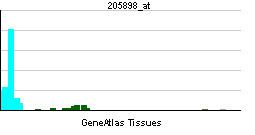Species Human Entrez 1524 | Human Mouse Ensembl ENSG00000168329 | |
 | ||
Aliases CX3CR1, CCRL1, CMKBRL1, CMKDR1, GPR13, GPRV28, V28, C-X3-C motif chemokine receptor 1 External IDs OMIM: 601470 MGI: 1333815 HomoloGene: 20350 GeneCards: CX3CR1 | ||
CX3C chemokine receptor 1 (CX3CR1) also known as the fractalkine receptor or G-protein coupled receptor 13 (GPR13) is a protein that in humans is encoded by the CX3CR1 gene. As the name suggests, this receptor binds the chemokine CX3CL1 (also called neurotactin or fractalkine).
Contents
Function
The fractalkine ligand CX3CL1 is a transmembrane protein and chemokine involved in the adhesion and migration of leukocytes. The protein encoded by the CX3CR1 gene is a receptor for the fractalkine ligand.
Expression of this receptor appears to be associated with lymphocytes. CX3CR1 is also expressed by monocytes and plays a major role in the survival of monocytes.
Fractalkine signalling has also recently been discovered to play a developmental role in the migration of microglia in the central nervous system to their synaptic targets, where phagocytosis and synaptic refinement occur. CX3CR1 knockout mice had more synapses on cortical neurons than wild-type mice.
Clinical significance
CX3CR1 also is a coreceptor for HIV-1, and some variations in this gene lead to increased susceptibility to HIV-1 infection and rapid progression to AIDS.
CX3CR1 variants have been described to modify the survival time and the progression rate of patients with amyotrophic lateral sclerosis.
Mutations in CX3CR1 are associated to dysplasia of the hip .
